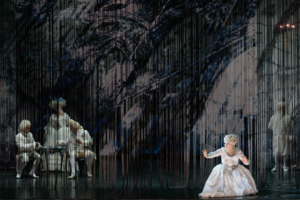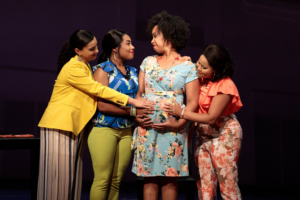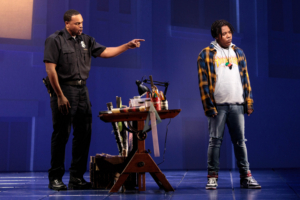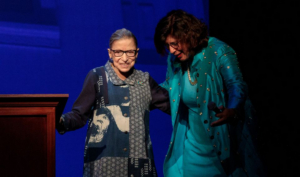Review: Am I BLUE at Glimmerglass? You Bet. But There Are Also Some Guilty GHOSTS, and, Oh that Notorious RBG!
A summer's sojourn to Cooperstown, NY, is for two distinct audiences: Those who come for the Baseball Hall of Fame and the baseball camps for kids (I only saw boys) between the end of Little League season and waiting the World Series to start. And then there were those like me, who come for the opera--the Glimmerglass Festival, under General Director Francesca Zambello, who also happens to run the Washington National Opera (WNO)-which combines the traditional (LA TRAVIATA), with musical theatre (SHOWBOAT) and newer compositions that may cross the line between genres.
In the latter category, this year, there were two works, both performed in the Festival's Alice Busch Opera Theater: One from the end of the 20th century, the John Corigliano-William Hoffman THE GHOSTS OF VERSAILLES (written for the 100th anniversary of the Metropolitan Opera, though not delivered on time) and a brand-new piece, BLUE by Jeanine Tesori and Tazewell Thompson, as up to date as #BlackLivesMatter.
THE GHOSTS OF VERSAILLES

Photo: Karli Cadel/Glimmerglass
GHOSTS, directed by Jay Lesenger with Eric Sean Fogel's choreography, starts in a style that looked like we were in for a production of Sondheim's FOLLIES. There's a group of spectres mixing in with living contemporaries and the characters in an opera, with some musical pastiche thrown in for good measure. That, however, was where the resemblance stopped. (The alternativey elegant and fanciful sets are by James Noone with Robert Wierzel's lighting. Sumptuous costumes were by Nancy Leary.)
If you're not familiar with the work--which was shown in a production from the LA Opera on PBS's Great Performances in 2017--it takes off from the third part of the Beaumarchais "Figaro" trilogy, THE GUILTY MOTHER. It continues the story of the characters in THE BARBER OF SEVILLE and THE MARRIAGE OF FIGARO, particularly Figaro himself, and adding a villain, Patrick Honore Beargass (Christian Sanders), for good measure.
Unfortunately, that third entry by Beaumarchais is not nearly as interesting as the others, as was shown once before, in the opera THE GUILTY MOTHER by Darius Milhaud, done by On Site Opera in NY back in 2017. Corigliano tries hard to liven things up, particularly with his music for Figaro, and has written some beautiful music for the other characters here and there-along with some snatches adapted from the music of the better known parts of the trilogy--but Hoffman's libretto is DOA.
Its new tale of the "walking dead" has Beaumarchais himself as a character trying to change history to save the life of Marie Antoinette from the guillotine because he's in love with her. The drama never really takes off, though there are a couple of instances, mostly the opera buffa moments, where it comes to life.
The mission of the company at Glimmerglass is to combine some seasoned singers with emerging artists. It's shown before to be good in theory--bringing in the newcomers--but not always successful in execution. This year's group of young artists, however, was exceptional.
Especially good were baritone Jonathan Bryan as Beaumarchais, with a smooth and sure portrayal of the hopelessly in love playwright; baritone Ben Schaefer showing off a decidedly bright voice and sense of stagecraft as Figaro; and mezzo Gretchen Krupp as Samira (so good last year in Janacek's CUNNING LITTLE VIXEN), who's a kind of cousin of Baba the Turk from THE RAKE'S PROGRESS, in one of this opera's best scenes.
As the young couple, Leon and Florestine--the illegitimate offspring of the Countess Almaviva (a/k/a Rosina) and Cherubino, the Count's page, and the Count and his paramour, respectively--tenor Spencer Britten and coloratura Emily Misch brought charm and liveliness to their roles. Mezzo Kayla Siembieda was fine as Susanna, a somewhat underwritten role in this part of the Beaumarchais story.
Of the more seasoned players, soprano Yelena Dyachek was a touching, glowing Marie Antoinette.
I was glad for the opportunity to see the Corigliano-Hoffman turn on the Beaumarchais story again, though i don't have strong memories of the original production at the Met, even with Teresa Stratas, Renee Fleming, Hakan Hakkegard and Marilyn Horne in major roles. On the other hand, I couldn't say I'm looking forward to seeing it again. (Unless, perhaps, in the short version that the creators did for smaller companies and schools, to see whether "less is more" really holds up.)
These GHOSTS will, however, have an afterlife, as a co-production with the Chateau de Versailles Spectacular in France.
BLUE

Photo: Karli Cadel/Glimmerglass
On the other hand, I came to the Festival eager to see the full version of BLUE, despite its realistically downbeat theme that, unfortunately, doesn't seem to improve in the current political climate. I saw highlights of it at the Guggenheim Museum's Works & Process series with the roundtable with creators along with highlights of the score.
I had been taken by Jeanine Tesori's pungent, multi-textured score--conducted forcefully by John DeMain--and the words that Tazemore Thompson chose to bring out the relationships, particularly the difficult interchanges between father and almost-grown son.
It solidified my feelings about how opera continues to live and breathe and is not something simply a museum piece--not that Handel, Verdi and others in the mainstream repertoire don't fill my life with beauty and dreams at a time when we can use all of those commodities that we can get. It convinced me further of the importance of the libretto in turning an operatic work into a living, breathing entity.

Photo: Karli Cadel/Glimmerglass
Yet I found, like many other pieces where I'd first seen excerpts, that it didn't quite live up to the potential that I hoped for. And most of the problems had to do with the libretto. At the Guggenheim, the opera's two strongest scenes were shown: One between the mother (the wonderful Briana Hunter, wonderful last month in NY as Hannah After in the Kaminsky-Reed-Campbell AS ONE at City Opera) and her closest friends (the strong trio of Ariana Wehr, Brea Renetta Marshall and Mia Athey). Their worries flew across the footlights as the Mother announced she was having a son and the friends asked whether it was likely, or even possible, to keep a young black male child safe today--even the child of a policeman, as the case was in this story.
The other scene previewed was the confrontation between the father (the strong baritone Kenneth Kellogg) and son (the exceptional tenor Aaron Crouch, featured in a recent Joyce DiDonato's masterclass at Carnegie Hall). The father is at a loss to get his son to consider his fears for the young man's safety, this son who has activist leanings. The father turns his concerns into confrontation, even about the clothes the boy wears--cautioning the son about wearing hoodies as something that might single him out as a troublemaker.
These scenes remained strong in the full-length presentation, as did a scene with the father and his pals (Aaron T Jenkins, Edward Graves and Nicholas Davis)--but other things appeared absent: The family relationships, between husband and wife, wife and son, the three together, seemed to be missing. (That is, until the coda to the story, which shows this 'happy family' as a mirage during [spoiler alert] the funeral for the son.) I later read in the program notes how Tesori and Tazewell wanted to show a "stable family with strong community ties" but I found that lacking in some ways.
I wondered whether it was a sociological thing, a racial thing that I wasn't getting--that Thompson, also the director, had insights that were not coming across to the non-African American segment of the audience--or that he took for granted as obvious. I found that the scenic design by Donald Eastman was disturbing, ghost-like in effect, houses without a way of getting in or out (no staircases into these buildings), lending an air of hopelessness that I wasn't sure was intentional. The costumes by Jessica Jahn, on the other hand, seemed just right.
The earlier scene, between father and son, was something I understood, having heard similar conversations between my wife, an attorney who frequently worked with police officers, and our daughters with activist leanings, loud opinions, and usually not afraid to express themselves. She told them how to act when confronted by police and they seemed to understand. We still worried every time they were protesting one injustice or another--even though the racial aspect of the interchanges was not an issue for us as it was in the opera.
Nonetheless, despite any misgivings on my part, the work remains powerful, with a gorgeous score and needs to have a further life--as indeed, it will at the Washington National Opera and Lyric Opera of Chicago.
ORDER IN THE COURT: JUSTICE GINSBURG

Francesca Zambello. Photo: Karli Cadel/Glimmerglass
In between these two more modern pieces there was a special treat for those who could swing a ticket: Justice Ruth Bader Ginsburg (a/k/a "the notorious RBG") introducing and providing commentary on a group of arias that related to the law and politics. Not only is she a justice, but also an opera buff, who even appeared in DAUGHTER OF THE REGIMENT at the WNO. The arias ran the gamut from THE MARRIAGE OF FIGARO to FIDELIO, from BILLY BUDD to THE CONSUL, plus a scene from DEAD MAN WALKING, which will be making it to the Met in a couple of years.
There was also a pair of arias that had special meaning to Justice Ginsburg, written by Patrice Michaels: one about an episode from the youth of the Justice's son (the composer's husband), the other by a heroine of hers, Anna Pauline "Pauli" Murray, an American civil rights and women's rights activist, lawyer, Episcopal priest and author.
Both excerpts were marvelous and the vignette from the Justice's own life was a funny, yet pointed, addition to the mainstream scores.
For more information, see the Glimmerglass Festival website. Further performances of GHOSTS will take place on August 3 (matinee), 9, 12 (matinee), 18 (matinee) and 23. BLUE will be seen tonight, August 2, then August 6 (matinee), 17 and 22. As for the Justice, you'll have to go see her on the bench.
Reader Reviews

Videos

